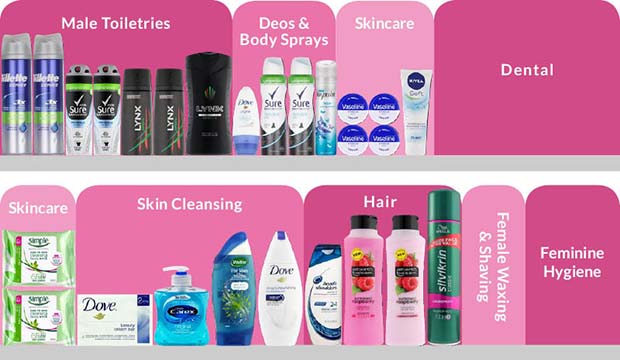Every household in the UK buys into the toiletries market. And, with certain items such as toothpaste, shower gel and deodorant being used every day, when they are running low or, worse, run out, shoppers look to replace them as quickly as possible.
 Shoppers are more likely to buy core toiletries, such as shower products or deodorants, in convenience stores as these are the products they are most likely to need to replace quickly.
Shoppers are more likely to buy core toiletries, such as shower products or deodorants, in convenience stores as these are the products they are most likely to need to replace quickly.
Shoppers are on an immediate need shopping mission. They do not browse. Retailers should focus on stocking a core range of bestsellers in these areas.
Nick Widdowson, Unilever’s Partners for Growth Merchandising and Creative Controller, says: “Top-up purchases form a large part of sales, so simplicity and visibility are key to a successful toiletries fixture, to enable shoppers to find what they want quickly and easily. Unfortunately 18% of shoppers do not know that Toiletries are sold in their local convenience store. As awareness can be low, and purchase is on impulse, retailers need to make it obvious to their customers that they stock Toiletries so POS is essential for retailers to advertise their range.”
Clip-strips or display units can drive additional sales. These can be seasonally themed, for example travel size deodorants in summer and lip-salves or hand-creams in winter. Help retailers create in-store or POS displays for promotional opportunities such as Fathers’ Day, Mothers’ Day, Movember and so on.
Shoppers are loyal to particular brands in toiletries, with 75% (CTP) of convenience shoppers saying that they intend to buy a leading brand in store. What shoppers want first and foremost is confidence that a product is going to perform well, particularly with deodorants, where confidence means not having to worry about odour and wet patches. With limited space, it is therefore important to stock the key brands shoppers know and trust. It is also important to offer choice to customers – a good range will cover a breadth of key needs.
Nick Widdowson continues: “in terms of haircare, the major growth areas are colourants, products which care for hair or repair problems such as split ends, products which are similar to those use in hair salons, men’s products and items for hair styling.”
Who is the toiletries customer and how do they shop?
The toiletries shopper is on an ‘immediate need’ shopping mission – they will buy products they cannot afford to run out of.
They require the fixture to be easy to locate in-store and have clearly laid out shelf and segmentation. For best results, follow these proven guidelines:
*Key need states by segment
*Breadth of needs rather depth of choice
* Best sellers
*Well-known brands – keep own label to a minimum as shoppers tend to be brand loyal
 Partners for Growth Retailer Advisory Panel
Partners for Growth Retailer Advisory Panel
Partners for Growth created the Retailer Advisory Panel to help convenience retailers to innovate and grow their sales. The award-winning members have been selected because they demonstrate best practice in merchandising and store layout, and lead the way in looking at ways to develop the convenience sector.
The Retailer Advisory Panel consists of David Charman, Dean Holborn, Jonathan James, Ramesh Shingadia, Kay Patel, Kishor Patel and Mandeep Singh. The Panel meets four times a year and the members have a key role in helping to shape the future of the Partners for Growth programme. They are also involved in educating and encouraging other retailers through the trade magazines and the Partners for Growth website.
Dean Holborn, one of the Panel members says: “The guidance offered by Partners for Growth is of great value to retailers, and that’s why I was keen to get involved in the Retailer Advisory Panel. By keeping up to date with the best sellers in each category, and merchandising effectively, retailers will reduce their wastage and increase their profits.”
Partners for Growth topline advice for retailers
Personal Care shoppers are looking for quality and product performance. Trusted brands provide shoppers with reassurance of value for money.
Core toiletries (everyday cleaning and caring needs) are purchased in a wide variety of channels and are the most important segment for convenience stores.
Focus on core toiletries, offering a breadth of needs rather than depth of choice. Use a planogram to ensure relevant products are grouped together and easy to shop.
High value toiletries can be a theft hazard, so ensure you can see the toiletries shelves from the till to limit losses.
Men are more likely to spend money on specialised products if they are separated into ‘male grooming’ area. Make sure these products are not sited next to femcare as this makes male shoppers uncomfortable
 Why toiletries are important in convenience
Why toiletries are important in convenience
Everyone uses toiletries, but some people use them on over 250 occasions a week (ETCD usage). 34% of convenience store shoppers are looking to buy toiletries (Europanel).
Toiletries shoppers spend more than the average convenience shopper, as they tend to use the visit to top up on other grocery items.
Haircare is showing good growth in convenience, driven by designer conditioners and treatments. In convenience, the washing and bathing sector has also grown.
Stocking male toiletries is an opportunity for retailers. This is a growing area in convenience (+3%) with deodorants, haircare and hairstyling showing the strongest growth (+5% each).
90% of men use deodorant – 80% buy it for themselves, so make sure it is easy to find on the fixture and not mixed with various female products.
The best range for convenience is one which features the top two or three products in each of the main subsections of toiletries, i.e. deodorants, haircare, skincare, shower, lip-care, bath etc. A range like this will meet the maximum number of shopper needs and thereby maximise your sales.




Comments are closed.